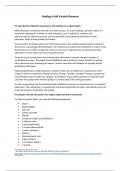Making a Nail Varnish Remover
P4: describe the industrial manufacture and testing of an organic liquid
Ethyl ethanoate, sometimes referred to as ethyl acetate, is a fruity-smelling, colourless liquid. It is
frequently employed as a solvent in many industries, such as adhesives, coatings, and
pharmaceuticals. Ethanol and acetic acid are esterified in the industrial production of ethyl
ethanoate, which is then purified and tested. 1
The interaction of ethanol with acetic acid in the presence of a catalyst (usually sulfuric acid) starts
the process of producing ethyl ethanoate. The reactants are heated and combined in a reactor vessel
during the process. After cooling, the mixture is moved to a separation jar to separate the ethyl
ethanoate from the acetic acid and unreacted ethanol.
To get rid of any contaminants, the isolated ethyl ethanoate is next put through a number of
purification processes. This might involve distillation, which produces a purer product by heating
ethyl ethanoate and condensing the vapour. Solvent extraction and filtration are possible further
purification techniques.
Following purification, ethyl ethanoate is tested to make sure it satisfies the requirements of the
usage for which it is intended. Testing for purity, density, viscosity, and other chemical and physical
characteristics may fall under this category. Analysing for any possible pollutants or impurities that
can lower the quality of the finished product is another step in the testing procedure.
In order to guarantee that the finished product satisfies the necessary requirements for its intended
application, ethyl ethanoate is manufactured and tested industrially through a convoluted process of
chemical reactions, purification, and testing.
P3: prepare and test the purity of an organic liquid and draw conclusions
To make an organic liquid, you need the following equipment:
Gloves
Safety goggles
Lab coat
Clamp and stand
Mantle
Condenser (reflux and distillation)
2 delivery tubes
1 pear shaped flask
1 round bottomed flask
1 water condenser
Ethanol
Glacial ethanoic acid
2 glass beakers
3 small glass beakers
1 spatula
1
DESCRIBE THE INDUSTRIAL MANUFACTURE AND TESTING OF ETHYL ETHANOATE,
https://www.studocu.com/en-gb/messages/question/2958480/discribe-the-industrial-manufacture-and-testing-of-ethyl-ethanoate,
29/05/2024
, Concentrated sulphuric acid
Separating funnel
Saturated calcium chloride solution
Sodium carbonate solution
1 plastic beaker
1 measuring cylinder
Method
1. I placed my pear-shaped flask into a plastic beaker to keep it upright.
2. I poured 25ml of ethanol into pear shaped flask, then poured 25ml of glacial ethanoic acid.
3. Then I gently swirled around and added 5 or 10ml concentrated sulphuric acid into the flask.
4. I placed my mixture to the side and set up my reflux condenser.
5. After setting up my condenser, I took my flask containing mixture and attached it to my
clamp so that it sat just above the mantle.
6. After setting up my flask, I made sure to connect one delivery tube to the tap of the sink and
the other side to the bottom of the condenser, while the second delivery tube was
connected to the top of the condenser and the other end placed inside the sink.
7. After making sure that everything is placed correctly, I turned the dial on the mantle to 10
and slowly reduced it as it was nearing a boil.
8. Once my flask started to boil, I turned off the mantle and let it cool down. While this was
happening, I set up my equipment for distillation.
9. Once my distillation set up was done, I made sure the delivery tubes were connected to the
right place. The delivery tube was connected to the tap and the condenser was placed near
the exit of the condenser, while the other delivery tube was in close distance with the
mantle and the other end placed in the sink.
10. Once this is done, I placed a new glass beaker underneath the end of the condenser. This is
where the distilled liquid ended up.
11. Once all the liquid had been distilled and collected in the beaker, I poured it into my
separating funnel. I also made sure the funnel was closed before pouring. (when the funnel
stopper is inline it is open – when funnel stopper is not inline it is closed)
12. After the liquid was in the separating funnel and was closed, I inverted it a few times, turned
it upside down and released any trapped gas by opening the tap on the funnel. I did this a
few times until I stopped hearing the fizz inside the funnel; this meant that there was no
more gas.
13. Next, I attached my separating funnel to my clamp and allowed the mixture to separate into
two layers.
14. Once I could see the two layers, I placed an empty beaker underneath the tip of the funnel.
15. I slowly released the tap so that only the bottom layer is left in the beaker and the top layer
remained in the funnel.
16. Once the bottom layer had been discarded into the beaker, I opened up the funnel and
poured 20ml of saturated calcium chloride inside.
17. After the saturated calcium chloride had been poured, I inverted it a few times and released
the gas, I did this a few times until there was no longer anymore gas.
18. Once there was no more gas, I released the bottom layer into the waste beaker from earlier,
until only the top layer remained in the funnel.
19. After the bottom layer had been discarded, I released the top layer into a new beaker and
added 1-2 scoops of sodium carbonate inside.
20. Next, I swirled the beaker gently and poured the liquid into a round-bottomed flask.




